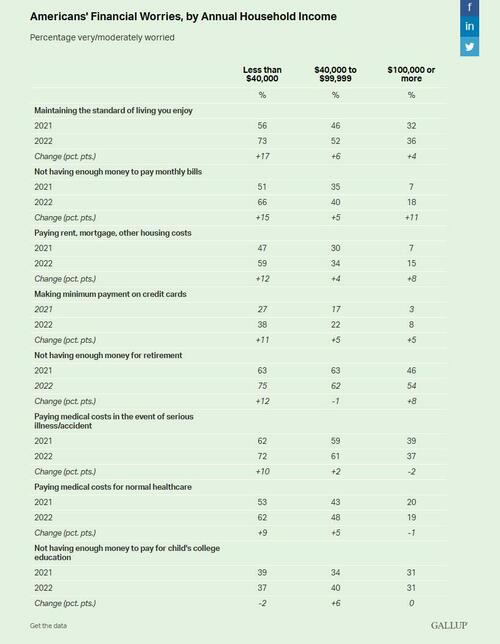
By Lydia Saad of Gallup
Americans are more likely today than they were a year ago to report being "very" or "moderately worried" about several aspects of their finances, reversing the improvement seen last year.
People's concern has increased the most about paying their monthly bills (up eight percentage points to 40%) and maintaining the standard of living they enjoy (up seven points to 52%). But concern has also increased, by five points, on paying one's rent or mortgage (35%), making minimum payments on credit cards (22%) and having enough money for retirement (63%).
Meanwhile, there has been little change in the percentages of U.S. adults worried about paying medical costs for normal healthcare (43%), paying medical costs for a serious health illness or accident (56%), or paying for a child's college education (36%).
Americans' financial anxieties increased in 2020 during the unprecedented economic shutdown that occurred at the start of the coronavirus pandemic. That proved temporary, as the percentage worried abated last year. That was as business as usual was resuming across the U.S. during the rollout of coronavirus vaccines. However, with inflation surging this year, concern is now back closer to 2020 levels on several items and is even higher on two.
-
The 52% now worried about maintaining their standard of living is four points higher than in 2020 and is the first time since 2016 that a majority has had this fear.
-
The 63% currently worried about having enough for retirement exceeds the 59% recorded in 2020 and marks the first time since 2016 that more than six in 10 have been this concerned about their retirement.
Despite holding steady, Americans' concern about affording expenses for a serious medical event is second only to retirement security in Americans' rank-order of concerns. Affording college is among the lower concerns for adults as a whole but is a top-tier concern for those with children, with 72% of parents worried.
The latest results are based on Gallup's Economy and Personal Finance poll, conducted April 1-19. The survey also found Americans' rating of their financial health sliding significantly, with a third citing inflation and another 10% citing energy costs as the top financial problems facing their family.
Worry Surges Among Low-Income Americans
The amount Americans worry about each of the eight financial matters is, as would be expected, strongly correlated with income. Worry among middle- and upper-income Americans has not changed meaningfully on most items, while the rates have soared among those in households making less than $40,000 per year.
Most notably, the percentage worried about maintaining their standard of living has increased 17 points among lower-income adults, from 56% in 2021 to 73% today. By contrast, it has increased six points to 52% among middle-income earners and four points to 36% among the top income group.
Similarly, the percentage of lower-income adults worried about paying their rent or mortgage, making their minimum credit card payments, affording retirement, and paying for medical care in the case of a serious illness or accident have all increased by 10 or more points, compared with small or no increases among higher-income adults.
In an exception to the generally small increases in financial concerns expressed by upper-income Americans, the percentages worried about paying monthly bills and paying their housing costs have about doubled, albeit from a low 7% last year to 18% and 15%, respectively, today.
Bottom Line
Inflation affects more than consumer spending and stock prices; it is causing anxiety among Americans about meeting their daily financial obligations and important savings goals. The increases among Americans as a whole have been fairly modest over the past year, but these mask a much greater rise in worry among lower-income Americans, two-thirds of whom now have doubts about just paying their monthly bills.
By Lydia Saad of Gallup
Americans are more likely today than they were a year ago to report being “very” or “moderately worried” about several aspects of their finances, reversing the improvement seen last year.
People’s concern has increased the most about paying their monthly bills (up eight percentage points to 40%) and maintaining the standard of living they enjoy (up seven points to 52%). But concern has also increased, by five points, on paying one’s rent or mortgage (35%), making minimum payments on credit cards (22%) and having enough money for retirement (63%).
Meanwhile, there has been little change in the percentages of U.S. adults worried about paying medical costs for normal healthcare (43%), paying medical costs for a serious health illness or accident (56%), or paying for a child’s college education (36%).
Americans’ financial anxieties increased in 2020 during the unprecedented economic shutdown that occurred at the start of the coronavirus pandemic. That proved temporary, as the percentage worried abated last year. That was as business as usual was resuming across the U.S. during the rollout of coronavirus vaccines. However, with inflation surging this year, concern is now back closer to 2020 levels on several items and is even higher on two.
-
The 52% now worried about maintaining their standard of living is four points higher than in 2020 and is the first time since 2016 that a majority has had this fear.
-
The 63% currently worried about having enough for retirement exceeds the 59% recorded in 2020 and marks the first time since 2016 that more than six in 10 have been this concerned about their retirement.
Despite holding steady, Americans’ concern about affording expenses for a serious medical event is second only to retirement security in Americans’ rank-order of concerns. Affording college is among the lower concerns for adults as a whole but is a top-tier concern for those with children, with 72% of parents worried.
The latest results are based on Gallup’s Economy and Personal Finance poll, conducted April 1-19. The survey also found Americans’ rating of their financial health sliding significantly, with a third citing inflation and another 10% citing energy costs as the top financial problems facing their family.
Worry Surges Among Low-Income Americans
The amount Americans worry about each of the eight financial matters is, as would be expected, strongly correlated with income. Worry among middle- and upper-income Americans has not changed meaningfully on most items, while the rates have soared among those in households making less than $40,000 per year.
Most notably, the percentage worried about maintaining their standard of living has increased 17 points among lower-income adults, from 56% in 2021 to 73% today. By contrast, it has increased six points to 52% among middle-income earners and four points to 36% among the top income group.
Similarly, the percentage of lower-income adults worried about paying their rent or mortgage, making their minimum credit card payments, affording retirement, and paying for medical care in the case of a serious illness or accident have all increased by 10 or more points, compared with small or no increases among higher-income adults.
In an exception to the generally small increases in financial concerns expressed by upper-income Americans, the percentages worried about paying monthly bills and paying their housing costs have about doubled, albeit from a low 7% last year to 18% and 15%, respectively, today.
Bottom Line
Inflation affects more than consumer spending and stock prices; it is causing anxiety among Americans about meeting their daily financial obligations and important savings goals. The increases among Americans as a whole have been fairly modest over the past year, but these mask a much greater rise in worry among lower-income Americans, two-thirds of whom now have doubts about just paying their monthly bills.







